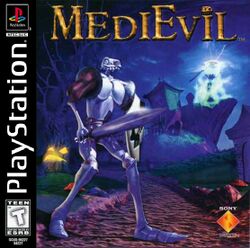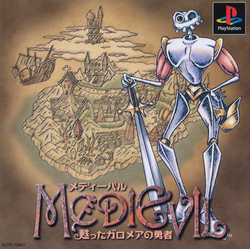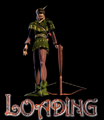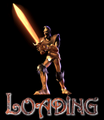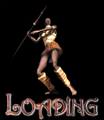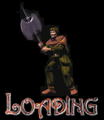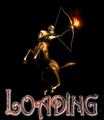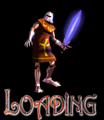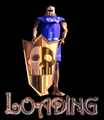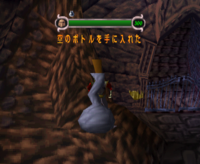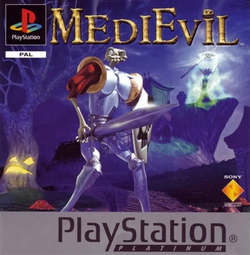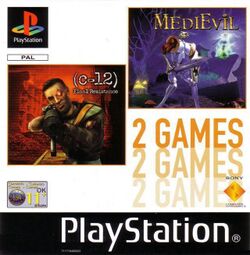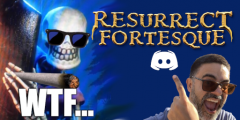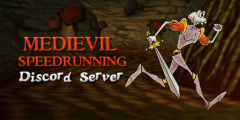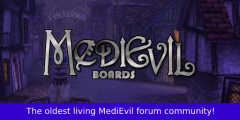|
| MediEvil | |||
|---|---|---|---|

| |||
| PAL region cover art. | |||
| Memory Card icon | |||
| AKA | Dead Man Dan | ||
| Tagline(s) | You'll be dying to play! A Gothic Tale Straight from the Grave. | ||
| Developer(s) | SCEE Cambridge Studio Implicit Conversions (2024 re-release) | ||
| Publishers | Sony Computer Entertainment | ||
| Platform(s) | PlayStation, PlayStation Network, Android (Xperia Play) | ||
| Release date(s) | October 9, 1998[1]
PlayStation: | ||
| Genre(s) | Action-adventure | ||
| Ratings | |||
| Mode(s) | Single-player | ||
| Serials | SCES-00311 (English)
SCES-01492 (French) | ||
| Next game | MediEvil 2 April 21, 2000 | ||
MediEvil is an action-adventure hack and slash video game developed by SCEE Cambridge Studio and published by Sony Computer Entertainment. It is the first installment in the PlayStation-exclusive MediEvil series. It follows the journey of Sir Daniel Fortesque, an undead knight undeserving of his reputation as a hero, as he embarks on a quest to redeem himself by defeating the evil sorcerer Zarok. Players need to make their way through the land of Gallowmere, defeating Zarok's minions and solving puzzles along the way.
Development on MediEvil began in 1995 at Millennium Interactive in Great Shelford. Originally targetting Windows 95 and the Sega Saturn for release, Sony's interest in publishing the game led to it becoming a PlayStation exclusive. Over the course of development, the game evolved from a simple Ghosts 'n Goblins-style arcade experience into a Zeldaesque action role-playing game.
MediEvil was released for the original PlayStation (PS1) on October 9, 1998 in Europe, October 21, 1998 in North America, and on June 17, 1999 in Japan. The game received mostly positive praise from critics upon release, but was criticised for its controls and cumbersome camera. Due to its success in Europe, the game was re-released there in late 1999 as a Platinum range title as well as in a bundle with C-12: Final Resistance on May 9, 2003. A sequel, MediEvil 2, was released in 2000 for the PlayStation, and MediEvil: Resurrection, a reimagining, was released in 2005 for the PlayStation Portable (PSP). Finally, a remake of the game for the PlayStation 4 (PS4) was released in 2019.
The game was re-released several times over the years. It was first made available for download on the PlayStation Network (PSN) in 2006. In 2011, the game was re-released for PlayStation® Certified Android devices such as the Xperia Play. In 2024, the game saw a PS4 and PlayStation 5 (PS5) re-release via the PlayStation Plus Premium service.
Gameplay
During the game, players must make their way through various locations, from a graveyard full of zombies, to a flying ghost ship commandeered by an undead pirate crew, to a levitating chessboard in an enchanted forest surrounded by flying demonettes. There are also several collectible items found in the levels which have to be collected in order to make progress. There are several books placed upon lecterns all over areas in the game which may offer advice to Sir Dan, while others contain humorous jokes or the history of the area. Some of them are hidden, but they are mostly found along the path that Sir Dan takes. They can be read if struck with a melee weapon.
Weapons
- Main category: Weapons in MediEvil
Dan starts the game with only his detachable arm, which can be used as both a melee and ranged weapon, but is incredibly weak. However, he obtains the small sword and some throwing daggers soon after. The majority of weapons Dan finds are received from the Hall of Heroes by collecting Chalices in each level, and range from swords, axes and hammers to projectile weapons such as crossbows and spears. There are other weapons that Dan finds through the course of the game, such as a club that can be used as a torch, but breaks after too much use; Dragon Armour that lets him breathe fire and makes him impervious to fire attacks; and Chicken Drumsticks that can turn enemies into Roast Chicken for health recovery. Dan is also able to find a variety of shields to protect himself, ranging from copper to gold in strength.
Chalice of Souls
- Main article: Chalice of Souls
Throughout the levels Sir Dan is presented with an opportunity to collect that particular level's Chalice by filling it up with the souls of his enemies. This mystical item allows him to visit the Hall of Heroes after the conclusion of the level. Dan can only collect the Chalice in each level when he has dispatched enough enough enemies to reach 100%. Chalices are hidden well and are not always at the end of a level, so Dan must sometimes backtrack to find them. In the Hall of Heroes, he can converse with past heroes, "await spiritual guidance" and receive useful items or weapons to help him in his quest. Collecting all the chalices allows the player to see the true ending.
Enemies
- Main category: Enemies in MediEvil
There are many adversaries Dan must face on his journey. Sticky-fingered imps, demonic scarecrows, and Zarok's boiler guards are but a few of the ghastly monstrosities that inhabit the land of Gallowmere. Some enemies can only be attacked either at certain times or using specific weapons, such as the scarecrows. Many weapons, such as swords and throwing daggers, can be charged up to produce a more powerful attack to finish enemies off more quickly.
Synopsis
Setting
MediEvil takes place in the Kingdom of Gallowmere, a fictional medieval kingdom filled with magical creatures, wizards, and witches. On the game's official US website and in promotional game materials, it was said that the game takes place in 847.[20] This was retconned in the game's sequel, where the year 1386 was revealed to be the true year of the game's events.[21]
During the time period the game takes place in, Gallowmere appears to be a Kingdom in decline - its seat of power, Peregrin Castle, lies in ruin. The Kingdom is leaderless and many of its areas are in disrepair. There appears to be only one major settlement left in the Kingdom: Gallows Town.
Characters
- Main category: Characters in MediEvil
- Sir Daniel Fortesque - The game's protagonist and playable character. He was King Peregrin's champion when he was alive. He was also one of the first men to die in the battle against Zarok and his Shadow Demons and was proclaimed Hero of Gallowmere by the king so that the people of the land would feel safe. When Zarok returns to raise an army of the dead, he also raises Sir Dan by mistake. Being given a second chance, Dan can finally prove himself a hero that he wasn't in his life by defeating Zarok.
- Zarok the Sorcerer - The game's antagonist. He was King Peregrin's advisor and mage until he began dabbling in Necromancy, which led the King to exile him from the land. Embittered and filled with wrath, he led an army of Shadowy demons into battle against the King. His army was defeated, however, by the King's militia and soon he was proclaimed killed by Sir Dan. In truth, Zarok went into hiding, only to return 100 years later to try and take over the land once again.
- King Peregrin - The past King of Gallowmere. He appointed Sir Dan a knight and banished Zarok from the land. He aids Dan in his quest by telling him how to defeat the Shadow Demons.
- Heroes - Canny Tim, Stanyer Iron Hewer, Bloodmonath Skull Cleaver, Woden the Mighty, Karl Sturnguard, Dirk Steadfast, RavenHooves the Archer, Imanzi Shongama and Megwynne Stormbinder, all aid Dan in his quest by giving him their weapons and other useful items.
Plot
In the Kingdom of Gallowmere, people recall an epic battle between Sir Daniel Fortesque, the King's Champion, and the King's former Court Magician, the evil sorcerer Zarok. In 1286, Zarok raised an army of demons and set out to take over the land. Legend has it that Fortesque led the King's army into battle against Zarok's demonic hordes and that Sir Dan himself killed the sorcerer during the battle - despite having been mortally wounded at the outset - cementing his posthumous status as the "Hero of Gallowmere."
Unbeknownst to the commonfolk, this official version of events was vastly exaggerated. Fortesque was not a hero at all, and was in fact the first to die during the Battle of Gallowmere. Although Sir Dan's troops managed to go on and win the battle without him, Zarok was able to escape and went into hiding, leading everyone to believe that he died.
A century later, in 1386, Zarok re-emerged. He robbed the citizens of Gallows Town of their souls and resurrected the dead in order to amass an undead army. Unwittingly, the wizard also revitalized the skeletal corpse of Sir Fortesque who immediately set out on a quest for redemption.
After finding a way out of the Necropolis and fighting his way through the land with help from Gallowmere's witches, the ghost of the last king, and the Boat Man of the dead himself, Sir Dan finally reached Zarok's Lair, where Zarok was waiting. There, Sir Dan faced Zarok's elite bodyguards known as the Fazguls, Zarok's undead champion Lord Kardok, and finally, the sorcerer himself. In a desperate bid to kill the warrior, Zarok cast a spell that brought the lair down on top of himself. Dan managed to escape in the nick of time and returned back to his crypt with help from a friendly vulture.
Endings
The ending is determined by whether or not Dan collected all the Chalices of Souls on his journey:
- Not all chalices collected: After Dan returns to his eternal rest, the camera zooms into his eye socket until the screen is completely black. The player is awarded a simple "The End" message, then the credits roll.
- All chalices collected: The same thing happens, only this time Dan ends up going to the Hall of Heroes. When he arrives, the rest of the heroes are already celebrating. They then notice that Dan has arrived and grow quiet, whispering about him. Dan then does a few acrobatics on the table and lands perfectly into the chair at its head, where he catches a cup that he flipped into the air with his foot. One of the heroes fills it up with wine, and Dan unsuccessfully drinks it (he is still in his skeletal form, therefore he has no throat). The other heroes then applaud him. The camera zooms out of the Hall and into the sky, where it shows a constellation of Dan in a heroic stance. "The End" message pops up and the credits roll.
Development
Development of MediEvil started in 1995 at independent developer Millennium Interactive. Chris Sorrell, previously known for the James Pond series, created the original concept for MediEvil and served as the game's creative director. Prior to the development of MediEvil, Sorrell had endured a rather torrid time working on some edutainment products that Millennium Interactive had signed up to create. "Once these products were finally complete, I think management took pity on me and rewarded me with the chance of making my dream game" he recalls. According to Sorrell, the first design proposal for the game described it as a fusion of Capcom's Ghosts 'n Goblins with the art style of Tim Burton – especially the look and feel of The Nightmare Before Christmas, both of which were things that he was a huge fan of back in the mid-'90s. Lead artist and designer Jason Wilson shared his interest in dark, Gothic influenced artwork and they worked together to define the look and feel of the game. Wilson was particularly inspired by German Expressionism from the 1920s and credits films such as Der Golem, The Cabinet of Dr Caligari, Nosferatu, Metropolis and Sunrise as his main sources of inspiration.[22] As development progressed, Wilson pushed the game into more of a Zelda-like direction as opposed to the original arcade-style concept. Sorrell approved of the new direction and said that he would liked to have expanded more on it.
From the outset, Sorrell wanted his game to possess a unique lead character. They worked with a script doctor named Martin Pond when looking for more of a backstory for the lead protagonist, Sir Daniel Fortesque. Pond came up with the idea that Sir Daniel could have been a pompous failure in life whose reincarnation was his one shot at redemption.
In addition to bringing together a brand new team – none of whom had really made a 3D game of this scale before – they were in 'sell' mode almost from day one, with the future of the studio riding on their ability to attract a major publishing deal as quickly as possible. They were initially working on multiple platforms including Windows and Sega Saturn as well as PlayStation before finally having the chance to pitch an early demo to Sony, who were so impressed with their work that they bought the whole studio and became Sony's second United Kingdom development studio. Late in the game's development, Sony requested that MediEvil should support the (then) new PlayStation analogue controller, which Sorrell described as a "particularly fortuitous event" as it allowed them to capture much more fluidity and intuitiveness within the game.
Sorrell said that MediEvil presented a mountain of challenges due to the fact that, like many other developers at the time, they were still very new to 3D gaming. Things like camera and character control presented many interesting new challenges and required the team to try out a number of approaches before settling on solutions that seemed to work. He said that they spent many long nights without sleeping, trying to finish the game. There were also many levels and ideas from the original concept that they were forced to remove because of time and budget constraints. In most cases, the best of what they had already created for those levels ended up being spliced into the levels that they shipped with. There was also intended to be a platform-oriented section of the game where the player would control the worm that lived in Daniel's skull. Concept art and a music track were created for this section, but it never materialized into the game. Even so, Sorrell said that the game still came very close to the original concept and he was most proud of how the team pulled together to finish the game without compromising on the quirky attention to detail or scope of the game.[23]
Within the game's memory, the following message can be found: "Buzby sucks eggs, and Eastwood smells!"[24] This refers to James Busby, the game's lead programmer, who left the project about two months prior to its release as a result of creative differences.[25][26]
Tools
Graphics
- Alias PowerAnimator - Used for creating the full-motion video (FMV) models and rendering them on an SGI machine.
- Avid Matador - Used to create textures for the FMV models.
- N-World - A 3D graphics package by Nichimen Graphics used for creating the in-game 3D models.[27][28]
- Photoshop 2 - Used for creating in-game textures.[27]
Other
- Mappy - In-house level mapping tool used to set up enemies, cameras and collisions for the game's levels.[29]
- Psy-Q Software Development Kit
Logo
The game's logo was made using the Ticonderoga typeface.[30] The Japanese logo uses a modified Harrington typeface for the part written in Latin script, with Japanese text using a modified JTCウイン ZM9 typeface.[31]
Soundtrack
- Main article: Les musiques de MediEvil
The original soundtrack of the game was made using electronic synthesizers to simulate an entire orchestra and organ. Paul Arnold and Andrew Barnabas composed the tracks. Chris Sorrell, the game's director, asked them to compose a Danny Elfman-style score, similar to those of Beetlejuice, The Nightmare Before Christmas and Batman Returns.[32]
The following tools, CD samples and software were used to create the soundtrack:[33]
- Roland JV1080 synthesizer
- Akai S3200 sampler using Peter Siedlaczek's "Orchestra", "Advanced Orchestra" and "Classical Choir" sample CDs
- Symphonic Adventures CD
- Emagic Logic Audio 3
- Digidesign Protools III PCI
Although there's no official soundtrack release, the 71st issue of the French magazine Joypad featured a CD named "Les musiques de Medievil," which contains ten tracks from the game and is the only "soundtrack" ever released for it.
Tracklist
| # | Track title | Composed by | Length |
|---|---|---|---|
| 1 | "The Awakening" | Andrew Barnabas, Paul Arnold | 2:12 |
| 2 | "Quest for Vengeance" | Andrew Barnabas, Paul Arnold | 2:10 |
| 3 | "Dan's Waltz" | Andrew Barnabas, Paul Arnold | 2:05 |
| 4 | "A difficult path" | Andrew Barnabas, Paul Arnold | 2:08 |
| 5 | "Morten's Dance" | Andrew Barnabas, Paul Arnold | 2:00 |
| 6 | "Enchanted Wood" | Andrew Barnabas, Paul Arnold | 2:09 |
| 7 | "Desecrated Church" | Andrew Barnabas, Paul Arnold | 2:14 |
| 8 | "Journey through the Crystal Caves" | Andrew Barnabas, Paul Arnold | 2:18 |
| 9 | "City in the Clouds" | Andrew Barnabas, Paul Arnold | 2:09 |
| 10 | "Triumph in Death" | Andrew Barnabas, Paul Arnold | 2:42 |
| 11 | "Stuttgart (Exciting)" | Jason Page | 3:20 |
| 12 | "Stuttgart (Panic)" | Jason Page | 3:05 |
| 13 | "Japan" | Jason Page | 3:15 |
| 14 | "USA" | Jason Page | 3:10 |
| 15 | "Alpine" | Jason Page | 3:45 |
| 16 | "Menu" | Jason Page | 1:54 |
Promotion
1996
MediEvil was first unveiled at the Spring European Computer Trade Show (ECTS) in April 1996.[34][35] It was later discussed in issue 35 of the video game magazine Edge where the studio's business development manager, Anil Malhotra, was interviewed about projects in development.[36] The game was slated for release in early 1997.[35][36.1]
1997
The game's next public appearance was at the third Electronic Entertainment Expo (E3) in America in 1997 where the MediEvil Prototype (June '97) was playable.[37][38] This was followed by a marketing push over Summer 1997 where MediEvil was featured in many magazines, including Edge, Joypad, and PlayStation Plus. Finally, the game appeared at the year's ECTS where the MediEvil ECTS Pre-Alpha could be played by attendees. The Sony ECTS 1997 PlayStation Press Pack featuring five discs with press information and promotional materials for Sony's latest titles was also given out to press members. Additionally, a disc known as the Winter Releases '97 demo 01 was distributed at the event as well.[39] This disc featured a rolling demo of MediEvil. A similar demo disc was sent out later in the year to people who registered their PlayStation console.[40]
1998
Some promotional posters for the game from this time period feature a cover art design that is different from the final one.
|
Release
MediEvil was initially released on October 9, 1998 in Europe and October 21, 1998 in North America. The game was dedicated to the memory of Mr. Apple.[41][41.1] It retailed at £39.99 in the UK.[42]
Versions
PAL region
Due to disc size and technical limitations, each Phase Alternating Line (PAL) region language version of the game received a standalone release. Besides localisation, there are virtually no differences between these versions. However, the Spanish and Italian versions of the game feature different game over music, likely in error.
The European versions of the game are among the first known instances of PlayStation games using LibCrypt protection in the region.[43]
NTSC region
Due to the higher refresh rate of the NTSC analog television standard, the game speed in this version is much faster than in the PAL region versions.
Land Map
The Land Map screen directional arrows were reworked. Instead of only showing the arrows for available directions, arrows for all directions are shown. Arrows for available directions are green and arrows for unavailable directions are red.
| PAL version | NTSC version |
|---|---|
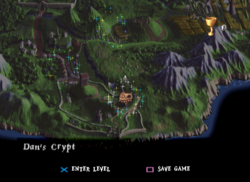 |
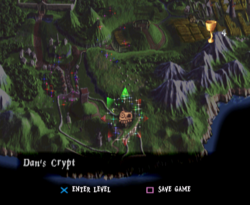 |
Scarecrow Fields
The haystacks in the Scarecrow Fields no longer shrink down when attacked or set on fire. This makes it impossible to claim the treasures within.
The Asylum Grounds
There is an additional hint book in The Asylum Grounds about the Clown hedge puzzle: "Show the Clown you care by surrounding him with smiles."
| PAL version | NTSC version |
|---|---|
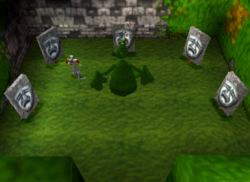 |
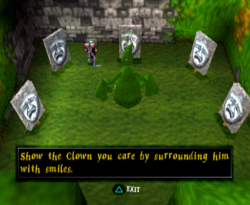 |
The Mad Monk enemies were reworked into the Grounds Keepers due to cultural differences, specifically the deep religiosity of some areas of the United States.[44]
| PAL version | NTSC version |
|---|---|
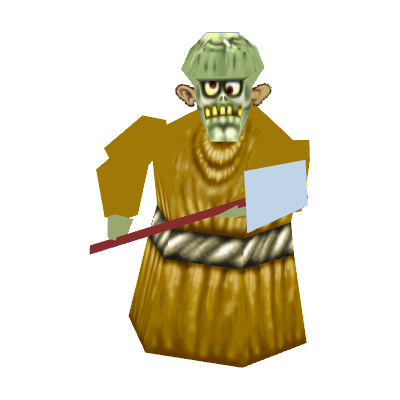 |
 |
NTSC-J region
The Japanese version of the game is based on the NTSC version, but contains numerous differences from it, even reverting some changes present in that version.
Visual changes
The most notable change in this version is Sir Dan's helmet. The helmet appears in full-motion videos (FMVs) as well as an inventory item in-game. This addition was a stipulation from the studio's Japanese partners, who were concerned that Dan's skeletal head might be seen as that of a bad spirit and not a 'hero' in Japan.[45]
| Original version | Japanese version |
|---|---|
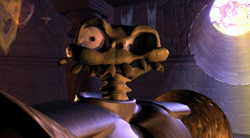 |
 |
Another change was the addition of an extra digit on character models that only had four fingers previously. This includes both in-game models and models in FMVs. In Japan, the number four can be pronounced the same way as the word for death (shi), making it an unlucky number. Additionally, Japan has a class of people suffering from discrimination known as the burakumin who worked in professions such as meat packing. They became associated with having four fingers due to work-related accidents. Later, a four-fingered hand gesture directed at another person came to mean that you were calling them burakumin. Depicting characters with four fingers thus became a sensitive issue in Japan.[46]
| Original version | Japanese version |
|---|---|
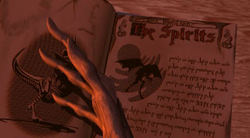 |
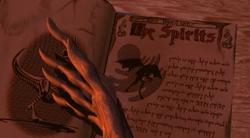 |
The game's loading and game over screens were updated to feature Dan's helmet, and the typeface used for the "LOADING" text was also changed to be the same as the one used for the game's Japanese logo.
| Original version | Japanese version |
|---|---|
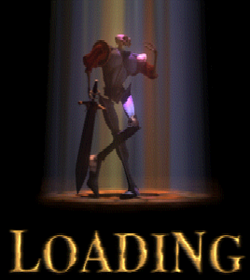 |
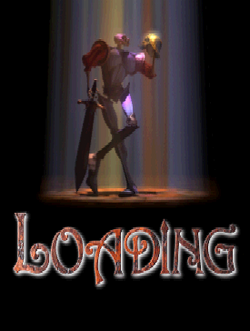 |
Nine new loading screens featuring the Heroes of the Hall were also added to the game:
Textual changes
- Dan's speech in cutscenes has been left unsubtitled. This makes it unskippable as a consequence.
- Several level names were changed. For example, The Graveyard became "Gallowmere Graveyard," The Hilltop Mausoleum was renamed to "Church," and the game's final level, known as Zarok's Lair in previous versions, is known as "The Chalice of Gallowmere" in this version.
- The message shown after defeating the Guardians of the Graveyard in Return to the Graveyard now tells the player how to perform the Daring Dash:
| Original version | Japanese version |
|---|---|
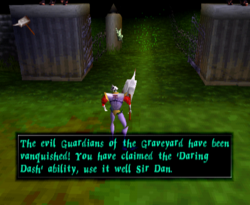 |
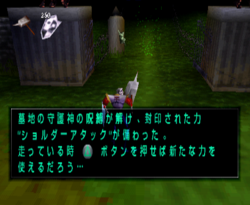 |
Gameplay changes
- Dan's Crypt features a unique item, the Empty Bottle. It works exactly as a regular Life Bottle but is empty to begin with. This was likely done in order to teach players about filling bottles up at Health Fountains.
- The Dragon Armour drains Dan's health when it is equipped. This creates a new bug where it is possible for Dan to die during cutscenes.
- Some of the in-game cutscenes have been adjusted with new camera angles and animations.
- The maximum gold value was capped at 30,000G. In the original game, this value was uncapped and could overflow.
- It is possible to recharge the Lightning at Merchant Gargoyles.
- It is possible to destroy the haystacks in the Scarecrow Fields like in the PAL versions.
- The hint book about the Clown hedge puzzle added to The Asylum Grounds level in the NTSC version of the game was removed:
| NTSC version | NTSC-J version |
|---|---|
 |
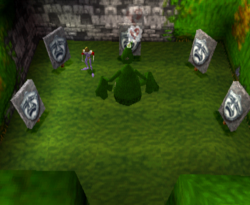 |
- A visual aid was added to the Shadow Demon tomb puzzle in The Enchanted Earth level. Notches around the center of the mural in the tomb indicate the order in which to press the buttons:
| Original version | Japanese version |
|---|---|
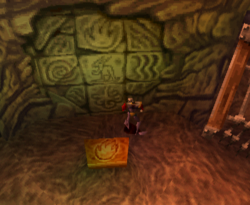 |
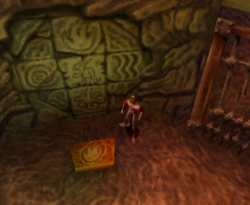 |
Bootlegs
|
Reception
| Reception | |
|---|---|
| Aggregate scores | |
| Aggregator | Score |
| GameRankings | 80.40%[47] |
| Review scores | |
| Publication | Score |
| Absolute PlayStation | 91%[48] |
| Electronic Gaming Monthly | 7.8/10 |
| Game Revolution | A−[49] |
| GameSpot | 8.2/10[50] |
| IGN | 7.8/10[51] |
| Official PlayStation Magazine (US) | 4/5 |
| PSM | 3/5 |
| PSX Extreme | 6.9/10[52] |
MediEvil received mostly positive reviews, with an 80.40% aggregate rating on Game Rankings.[47] The game received a 7.8/10 from IGN.[51] IGN heralded it as "A fun game and one of PlayStation's classics". GameSpot gave it an 8.2/10, proclaiming that the game is a "welcome surprise".[50] Game Revolution gave the game an A− and stated that "what we have here is one of the cleverest platform games ever made".[49]
According to Jason Wilson, market research for the game in 1998 revealed that the game scored very highly with female gamers, especially in France.[53]
Sales
The game sold over 800K units world-wide by November 1, 1999.[54] The studio was awarded a plaque from Sony for selling 250K copies of the game in the fiscal year ending March 31, 1999. The plaque was auctioned off on eBay in the year 2020.[55]
Accolades
MediEvil was featured within The Guinness Book of Records 1999 due to having the "Most Advanced 3-D Animation."[56][56.1]
Re-releases
Platinum
Due to the game's relative success in Europe, it was re-released as a Platinum range title in late 1999.[4] According to Ukiepedia, this re-release was the 96th best-selling game release of the year 1999 in the UK.[57]
Inside copies of this version was a poster featuring an insight into MediEvil's sequel, MediEvil 2. This showed off new characters and levels, set in 19th century London. On the reverse of the poster are map instructions for the first four levels of the game. These include details of the locations of vials, Chalices, Life Bottles, Rune Stones, gargoyles, rune hands, copper and silver shields, weapons, and other secrets which may only be accessible after finding certain items or completing specific tasks.
"2 Games" pack
MediEvil was re-released in a "2 Games" pack with Cambridge Studio's final PS1 game C-12: Final Resistance on May 9, 2003, exclusively in Europe.[5] While each game came on its own disc, their manuals were combined.
PlayStation Network
MediEvil was first re-released on the PSN around December 23, 2006 in North America.[6] Initially it could only be played on a PSP, but had to be downloaded using a PlayStation 3 (PS3). The PS3 received firmware update 1.7 on April 19, 2007, which promised to make PS1 games downloaded through the PSN playable on the console. However, the titles themselves were not updated to work on PS3 yet.[58] This update came a few weeks later on May 9, 2007.[59]
MediEvil was set to release on PSN in Europe on June 22, 2007.[60][61] However, this did not happen. The game was eventually released a month later on July 26, 2007.[62] Unfortunately, the game was removed the next day due to "failing at the third level."[63][64] Sony began to issue refunds for the game that August.[65] A fully working version of the game was finally released on September 20, 2007.[7][8] From August 2010 to September 2010, this version was made available for free to European PlayStation Plus subscribers.[66]
The Japanese version of the game was released on the Japanese PSN on November 28, 2007.[9]
Years later, on April 16, 2024, the game saw another PSN re-release made specifically for the PS4 and PS5 consoles. This version was prepared by the company Implicit Conversions, and was enhanced with up-rendering, rewind, quick save, custom video filters and trophy support.[10]
Android
The Android re-release of the game, available exclusively on Xperia Play phones, saw very low sales numbers in its first month, selling between 100 to 500 units in total.[67]
Legacy
|
Credits
| Game Concept/Direction | Chris Sorrell |
|---|---|
| Game Design | Jason Wilson |
| Main Programming | James Busby, Paul Donovan, Chris Sorrell, Matt Johnson, Sam Baker |
| Additional Programming | Derek Pollard, Tim Closs, Dean Ashton |
| Mapping/Development Assistant | Katie Lea |
| Art Design | Jason Wilson |
| Rendered Sequences/Presentation Visuals | Jason Riley |
| Additional Mapping | Lindsay Pollard |
| AV Management | Pete Murphy |
| Original Soundtrack | Andrew Barnabas, Paul Arnold |
| Sound Effects | Paul Arnold |
| Video Post-Production | Tom Oswald |
| Speech Post-Production | Andrew Barnabas |
| Sound Effects/Language Implementation | Gary Richards, William Bell |
| Technologies Management | Mike Ball |
| Technologies Programming | Andrew Ostler, Dean Ashton, Matt Johnson |
| QA Testing Co-ordinator | Sarah-Louise Lloyd |
| QA Testers | Dave Holloway, Alex Sulman, Dan Smith, Stuart Harvey |
| Preliminary Script | Jason Wilson |
| Dialogue Script | Martin Pond |
| Producer | Chris Sorrell |
| Manager (Cambridge Studio) |
Ian Saunter |
| Executive Producer for SCEE | John Roberts |
| Product Manager | Chris Ansell |
| Manual | Written by Jim Sangster
Designed by Steve O'Neill |
| Print Production | Martin Pearce |
| Manual QA Approval | Lee Travers, Stephen Griffiths |
| QA Manager | Tony Bourne |
| Head of the Internal Testing | Steve Archer |
| Testing Co-Ordinator | Jim McCabe |
| Lead Tester | Dave Burke |
| Assistant Lead Tester | Andy Macoy |
| Testers | Ian Cunliffe, Richard Bunn, Anthony Gill, John Cassidy, Dominic Berzins, Ian McEvoy, Phil Bramhill, Dee Norfolk, Lorna Croasdale, Pat Cowan, Carl McKane, Carl Guinney |
| Lead Localisation Tester | Ed Valiente |
| Localisation Testers | Claudia Schuldt, Christa Leonards, Lucie Dupoirieux, Susana Olga Paredes Alcaraz, Ana Maria Juarez-Ordóñez, Andrea Masneri, Miguel Sanchez |
| VOICE ARTISTS | |
| Luis Soto, Paul Darrow, Harry Dickmen, Christopher Kent, Helen Lederer |
Gallery
|
In other languages
| Language | Official Name | Meaning |
|---|---|---|
| Arabic | ميد ايفل mid ayfil |
- |
| Chinese (Simplified) | 骷髅战士 Kūlóu zhànshì |
Skeleton Warrior |
| Japanese | メディーバル 甦ったガロメアの勇者 Medībaru yomigaetta garomea no yūsha |
MediEvil: Resurrected Hero of Gallowmere |
| Korean | 메디이블 mediibeul |
- |
See also
 MediEvil fan comic.
MediEvil fan comic. MediEvil fan film.
MediEvil fan film. MediEvil: Hero of Gallowmere mod for The Elder Scrolls V: Skyrim.
MediEvil: Hero of Gallowmere mod for The Elder Scrolls V: Skyrim. MediEvil: Undead Again fan game.
MediEvil: Undead Again fan game.
References
- ↑
 Welcome on MediEvil Official EU Website (archived version).
Welcome on MediEvil Official EU Website (archived version).
- ↑ Challenge the Powers of Darkness in the Gothic World of MediEvil in Business Wire. Published October 21, 1998.
- ↑ Nelson, Randy & Perry, Douglass, MediEvil on IGN. Published October 22, 1998.
- ↑ 4.0 4.1 Official Australian PlayStation Magazine No. 26, page 81. Published by ACP Publishing in September 1999.
- ↑ 5.0 5.1 PSone Twin Pack: C12/Medievil on Amazon.co.uk (archived version). Retrieved May 16, 2023.
- ↑ 6.0 6.1 Doerr, Nick, Even more stuff to download from the PS-Store on Engadget. Published Deccember 23, 2006. Retrieved April 25, 2023.
- ↑ 7.0 7.1 Barker, Anthony, PSN Content 20/09 (US & Europe) on Console Monster. Published September 20, 2007. Retrieved April 27, 2023.
- ↑ 8.0 8.1 PSN STORE UPDATES on Three Speech. Published September 20, 2007. Retrieved April 28, 2023.
- ↑ 9.0 9.1 メディーバル 甦ったガロメアの勇者 on プレイステーション® オフィシャルサイト (archived version). Retrieved April 27, 2023.
- ↑ 10.0 10.1 Michel, Adam, PlayStation Plus Game Catalog for April: Dave the Diver, Tales of Kenzera: Zau, The Crew 2 and more. Published April 10, 2024. Retrieved April 11, 2024.
- ↑ Wong, Raymond, PlayStation Games for Xperia Play Show Up in Android Market on Ubergizmo. Published March 31, 2011.
- ↑ Nelson, Randy, PSOne games begin appearing on Android Market, limited to Xperia Play on Engadget. Published March 31, 2011.
- ↑ MediEvil on Pegi Public Site.
- ↑ MediEvil on نظام ارزیابی و رده بندی سنی بازی های رایانه ای.
- ↑ MediEvil (PS One) on ESRB.org.
- ↑ MediEvil (PS3, PS Vita, PSP) on ESRB.org.
- ↑ Medievil® (메디이블®) on 게임물관리위원회. Published April 27, 2011.
- ↑ MEDIEVIL on Australian Classification Board. Published January 9, 1998.
- ↑ MediEvil on Unterhaltungssoftware Selbstkontrolle. Published August 5, 1998.
- ↑
 MediEvil on MediEvil Official US Website (archived version at Internet Archive Wayback Machine).
MediEvil on MediEvil Official US Website (archived version at Internet Archive Wayback Machine).
- ↑
 MediEvil 2. Developed by SCEE Cambridge Studio. Published by Sony Computer Entertainment on April 21, 2000.
MediEvil 2. Developed by SCEE Cambridge Studio. Published by Sony Computer Entertainment on April 21, 2000.
- ↑
 Wilson, Jason, Reference and inspiration for the game MediEvil on Facebook. Published November 3, 2014.
Wilson, Jason, Reference and inspiration for the game MediEvil on Facebook. Published November 3, 2014.
- ↑ Dutton, Fred, Behind the Classics: MediEvil on PlayStation.Blog. Published September 7, 2012.
- ↑
 Hidden Programmer Message on MediEvil Boards. Published January 28, 2012.
Hidden Programmer Message on MediEvil Boards. Published January 28, 2012.
- ↑
 "Ha - 'that' message! Buzby refers to the game coder - James Busby, I think it was an affectionate joke. The 'Eastwood' thing is a private joke known by only a few members of the original team and I couldn't possibly explain it! :)" — Wilson, Jason, MediEvil developers - Q&A; on MediEvil Boards. Published February 10, 2012.
"Ha - 'that' message! Buzby refers to the game coder - James Busby, I think it was an affectionate joke. The 'Eastwood' thing is a private joke known by only a few members of the original team and I couldn't possibly explain it! :)" — Wilson, Jason, MediEvil developers - Q&A; on MediEvil Boards. Published February 10, 2012.
- ↑ RETRO Volume 8, page 130. Published in 2015 by Imagine Publishing Ltd.
- ↑ 27.0 27.1 jason wilson medievil design history on atomic-city concept art and design of Jason Wilson (archived at Wayback Machine Internet Archive). Retrieved January 4, 2022.
- ↑ "Nichimen Graphics Inc., a company known for helping developers build 3D animation into such games as Super Mario, Final Fantasy VII, and MediEvil, has announced its latest suite of software development tools called Mirai." — Mullen, Micheal, Nichimen Introduces New Animation Tool on Gamespot. Published April 27, 2000. Retrieved January 4, 2022.
- ↑
 Sorcerers - Katie Lea: LEVEL MAPPING on MediEvil Official EU Website (archived version).
Sorcerers - Katie Lea: LEVEL MAPPING on MediEvil Official EU Website (archived version).
- ↑ "Ticonderoga was used for the logo of the 1998 video game MediEvil. It’s featured in all caps, with letterforms of varying size and condensation, effects, and a custom skull on top of the second I. The logo appears in the game itself, as well as on the game packaging, and in advertisements for the game." — MediEvil video game logo on Fonts In Use. Published December 21, 2024. Retrieved January 3, 2025.
- ↑ "Harrington was used for the logo of the Japanese release of the video game MediEvil. It’s primarily featured in all caps, safe for the first e, with letterforms of varying size. Some of the letter shapes have been customised, such as the first e and the Is. The logo appears in the game itself, as well as on the game packaging, and in advertisements for the game.
The font used for Japanese text is JTC Win ZM9. Some of the character shapes have been customised with flourishes and sharper ends." — MediEvil video game Japanese logo on Fonts In Use. Published December 28, 2024. Retrieved January 3, 2025. - ↑ Ittensohn, Oliver, Interview with composer Paul Arnold on GSoundtracks. Retrieved 18 May, 2012.
- ↑ Medievil 2 case study on Bob and Barn (archived at Wayback Machine Internet Archive).
- ↑ Speciale Ects Spring '96 (ECTS Spring '96 Special) in K, Issue 84, page(s) 48. Published May 1996 by R.C.S. Libri e Grandi Opere S.p.A..
- ↑ 35.0 35.1 Новости с ECTS (News from ECTS) in PRO Игры Magazine, Issue 10, page(s) 23. Published May 1996.
- ↑ An audience with... Millennium in Edge, Issue 35, page(s) 22-26. Published August 1996 by Future Publishing.
- ↑ If the game matches the technical expertise and the imagination and thoroughness of the design, Medievil could be a serious contender early next year. in An audience with... Millennium in Edge, Issue 35, page(s) 22-26. Published August 1996 by Future Publishing.
- ↑ GameFan Presents 1997 E3 in GameFan, Volume 5 Issue 8, page(s) 74-75. Published August 1997 by Metropolis Publications.
- ↑ E3 Preview MediEvil on PSX Nation (archived version). Published June 21, 1997.
- ↑ Goring, Graham, ECTS - Lotta BBW's on uk.games.video.playstation. Published September 8, 1997. Retrieved April 22, 2022.
- ↑ Latah, Is There A Mailing List on uk.games.video.playstation. Published December 1, 1997. Retrieved April 22, 2022.
- ↑
 MediEvil. Developed by SCEE Cambridge Studio. Published by Sony Computer Entertainment on October 9, 1998.
MediEvil. Developed by SCEE Cambridge Studio. Published by Sony Computer Entertainment on October 9, 1998.
- ↑ Credits in
 MediEvil. Developed by SCEE Cambridge Studio. Published by Sony Computer Entertainment on October 9, 1998.
MediEvil. Developed by SCEE Cambridge Studio. Published by Sony Computer Entertainment on October 9, 1998.
- ↑ Credits in
- ↑ "I don't know if everyone is aware of this, but Medievil is out now in the UK - priced £39.99." — MediEvil Out Now - UK !! on uk.games.video.playstation. Published October 8, 1998. Retrieved July 17, 2021.
- ↑ SBI FILES on The PlayStation Datacenter.
- ↑
 "We might speak the same language but there are cultural differences between the UK and the US. We had to make a number of concessions to the US due to the deep religious views of some States." — Jason Wilson (@GunnWriter) on X (formerly Twitter) (archived version at Internet Archive Wayback Machine). Published October 8, 2019. Retrieved November 1, 2024.
"We might speak the same language but there are cultural differences between the UK and the US. We had to make a number of concessions to the US due to the deep religious views of some States." — Jason Wilson (@GunnWriter) on X (formerly Twitter) (archived version at Internet Archive Wayback Machine). Published October 8, 2019. Retrieved November 1, 2024.
- ↑
 "For Medievil there was a worry in Japan that Dan's skeletal head might be seen as a bad spirit and not a 'hero.'" — Wilson, Jason, MediEvil developers - Q&A; on MediEvil Boards. Published December 25, 2012.
"For Medievil there was a worry in Japan that Dan's skeletal head might be seen as a bad spirit and not a 'hero.'" — Wilson, Jason, MediEvil developers - Q&A; on MediEvil Boards. Published December 25, 2012.
- ↑ FAQ - OTHER on Oddworld Inhabitants. Retrieved January 8, 2025.
- ↑ 47.0 47.1 MediEvil for PlayStation on GameRankings.
- ↑ MEDIEVIL - Review on ABSOLUTE PLAYSTATION (archived version). Published November 1998.
- ↑ 49.0 49.1 MediEvil Review on Game Revolution. Published October 1998.
- ↑ 50.0 50.1 Joe Fielder, MediEvil Review on GameSpot. Published October 23, 1998.
- ↑ 51.0 51.1 Randy Nelson and Douglass Perry, MediEvil on IGN. Published October 22, 1998.
- ↑ Medievil Review on PSX Extreme. Published July 7, 1999.
- ↑
 "During market research for the game in ‘98, MediEvil was found to score very highly with female gamers, especially in France. Women found Sir Dan an appealing character and different to usual macho game characters." — Jason Wilson (@GunnWriter) on X (formerly Twitter) (archived version at Internet Archive Wayback Machine). Published October 9, 2018.
"During market research for the game in ‘98, MediEvil was found to score very highly with female gamers, especially in France. Women found Sir Dan an appealing character and different to usual macho game characters." — Jason Wilson (@GunnWriter) on X (formerly Twitter) (archived version at Internet Archive Wayback Machine). Published October 9, 2018.
- ↑
 Press Release on MediEvil 2 Official Website (archived version).
Press Release on MediEvil 2 Official Website (archived version).
- ↑
 "...Finally we have a 1999 gold plaque the studio received for 250K copies..." — Alex Kanaris-Sotiriou (@Kanaratron) on X (formerly Twitter) (archived version at Internet Archive Wayback Machine). Published November 8, 2020.
"...Finally we have a 1999 gold plaque the studio received for 250K copies..." — Alex Kanaris-Sotiriou (@Kanaratron) on X (formerly Twitter) (archived version at Internet Archive Wayback Machine). Published November 8, 2020.
- ↑ The Guinness Book of Records 1999. Published by Guinness Publishing Ltd. in October 1998.
- ↑ "MediEvil, developed by Sony Computer Entertainment Europe - Cambridge Studios, uses N-World, a modelling and painting package from Nichimen Graphics Inc., which has also been used to produce Super Mario 64 and Final Fantasy VII." — Page 170 of The Guinness Book of Records 1999. Published by Guinness Publishing Ltd. in October 1998.
- ↑ UK Top Selling Games 1999 on Ukiepedia. Retrieved May 16, 2021.
- ↑ "As some PlayStation 3 owners have already discovered, however, the existing PS One software currently available for download doesn't work. Popular speculation as to why this is points to the need to remove the certification key required to play games on Sony's portable platform." — Dunham, Jeremy, PS1 Downloads on PS3 Explained on IGN. Published April 19, 2007. Retrieved December 20, 2024.
- ↑ "Well, it's May and Sony has announced that the PSone format software available from the PlayStation Store will now be operable on both the PS3 and PSP systems. If you've already purchased any titles, you'll be able to re-download them to your PS3 at no additional charge." — Grant, Christopher, PSone titles now working on PlayStation 3 and PSP on Engadget. Published May 3, 2007. Retrieved December 20, 2024.
- ↑ PS STORE RELEASE DATES CONFIRMATION on Three Speech (archived version). Published June 15, 2007. Retrieved April 27, 2023.
- ↑ Yoon, Andrew, Europe finally gets PS1 downloads on Engadget. Published June 15, 2007. Retrieved April 27, 2023.
- ↑ NEW CONTENT AVAILABLE ON THE PSN - THURSDAY 26TH JULY on Three Speech (archived version). Published July 23, 2007. Retrieved April 28, 2023.
- ↑ "After some of you pointed out that MediEvil fails at the 3rd level we have withdrawn the title from the PLAYSTATION®Store for the time being." — Lestrade, MediEvil & Spyro issues on Official PlayStation Community (archived version). Published July 27, 2007. Retrieved April 28, 2023.
- ↑ "Sony has confirmed to Eurogamer that problems with one of the downloadable PSone games released on PlayStation Network last Thursday have led to its withdrawal." — Bramwell, Tom, MediEvil and Spyro PSN bugs on Eurogamer. Published July 30, 2007. Retrieved April 28, 2023.
- ↑ "Sony has said it will refund consumers who bought PSone title Spyro 2: Gateway to Glimmer and now MediEvil from the PlayStation Store." — Bramwell, Tom, Sony refunds borked PSN games on Eurogamer. Published August 10, 2007. Retrieved April 28, 2023.
- ↑ PlayStation Plus Content For August And September on PlayStation.Blog.Europe.
- ↑ Jenkins, David, PSone game sales on Xperia Play below 1,000 downloads on GamesIndustry.biz. Published May 12, 2011.
External links
| ||||||||||||||||||||||||||||||||||||||||||||||||||||||||||||||||||||||||||
Gaming Wiki Network
 Discord • X (Twitter) |
The GWN is an affiliation between independently-hosted wikis about video games. | ||
|
We are also affiliated with:
| |||
